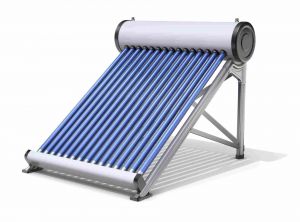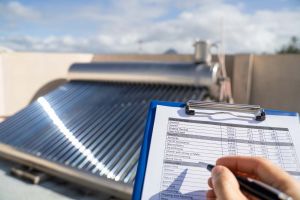So, what is an evacuated tube system? What are the different types and how is it installed? Our Canstar Blue guide will tell you everything you need to know about this advanced process of converting the sun’s rays into hot water before your next bubble bath.
On this page:
- What is an evacuated tube solar collector?
- How do evacuated tube solar collectors work?
- Types of evacuated tube solar collectors
- What are evacuated solar tubes made from?
- How to install an evacuated tube solar hot water heater
- Solar hot water: Evacuated tube vs flat plate vs heat pump
- Is evacuated tube solar right for me?
Advertisement
What is an evacuated tube solar collector?

Evacuated tube solar collectors are a component of solar hot water systems. Like solar panels, they’re mounted to your roof. Evacuated tube solar hot water systems convert the sun’s rays into energy that heats water for your home. This system is made up of a series of glass tubes that contain heat pipes.
How do evacuated tube solar collectors work?
Evacuated tube solar hot water systems come in different varieties, but the basic idea is the same. The heat pipes, or plates, contained within the tubes trap UV rays and generate heat. Because this system uses UV rays and not necessarily sunlight or temperature, it works even on overcast days.
The heat is then vacuumed or ‘evacuated’ to the manifold, a heat transferral system. The manifold houses a water pipe connected to your hot water tank.
Types of evacuated tube solar collectors
Not all solar hot water systems are made equal — there are different vacuum tube configurations on the market. Depending on the type of system and how water is heated, vacuum tubes come in various sizes and configurations. Two common evacuated tube system types are listed below.
Heat pipe evacuated tube collector
Heat pipe evacuated tubes use a vacuum system where a copper heat pipe is attached to a heat-reflecting fin. A small amount of low-pressure liquid sits in the bottom of the tube, which vapourises as the sun’s rays heat the chamber. The hot vapour then rises to the top of the pipe and enters the manifold. The vapour is then used to heat the water that runs through the manifold. As the vapour cools, it becomes liquid again and flows back down the tube for the process to begin again.
Direct flow evacuated tube collector
Direct flow tubes have two heat pipes that run through the tube connected at the bottom with a “U” shaped bend. Fluid enters through one pipe and exits through the other. Through this process, the liquid is warmed by the sun’s rays. The thermal energy generated by the direct flow process is then transported to a heat exchanger and the manifold.
What are evacuated solar tubes made from?

Evacuated solar tube systems are comprised of seven main elements:
- Outer tube: The outer tubes are made from durable, transparent borosilicate glass that allows the sun’s rays to pass through easily.
- Inner tube: The inner tubes are also made from borosilicate glass with a selective coating to help with heat absorption and provide thermal stability.
- Heat pipe: A copper pipe that sits within the inner tube to transfer heat to the manifold.
- Fin: An aluminium fin that supports the heat pipe and prevents heat loss as heat travels to the manifold.
- Getter: A deposit of barium between the outer and inner tubes that absorbs air and maintains the vacuum.
- Manifold: A weatherproof box containing copper pipes that connect to the heat pipes.
- Frame: A strong frame usually made of metal for mounting the system on your roof.
How to install an evacuated tube solar hot water heater
You can’t DIY solar hot water heater installation. It’s one thing to understand how evacuated tube systems work, but technical installations should be left to the experts. That said, here’s an idea of what your solar energy installer is doing up on your roof:
- Attaching copper lines between the evacuated tubes and manifold
- Connecting the evacuated tube system to your hot water system
- Installing sensor cables and circulation pumps
- Mounting the system to your roof at an optimal angle and pitch
Solar hot water: Evacuated tube vs flat plate vs heat pump
Evacuated tube systems aren’t the only solar hot water system available in Australia. There are three types of solar water heaters: flat plate, evacuated tube and heat pump.
Flat plate
A flat plate collector is, as its name suggests, a flat, insulated, rectangular panel with durable glass above and a black energy-absorbing plate below. During the day, the sun’s rays heat copper pipes inside the collector and warm the water in your storage tank. This system is typically the cheapest.
Evacuated tube
The latest in solar hot water heating technology, evacuated tube hot water systems heat water through a vacuum and vapour system. Sunlight or humidity can heat the tubes that run down to your hot water storage tank. This system can provide hot water day or night, rain or shine.
Heat pump
While heat pumps do not use solar panels to heat water, they still use the sun’s energy. It’s simple — a heat pump converts air heat into water heat. Despite the name, heat pumps don’t necessarily require sunlight or high temperatures — a good system should function even in freezing weather.
Each system has pros and cons, but the choice ultimately comes down to you. While a flat plate or heat pump system is the most affordable upfront, evacuated tube systems may save you money in the long run due to their increased efficiency.
Compare Solar Plans & Prices
Here are some of the cheapest solar-specific deals from the retailers on our database. These costs are based on the Ausgrid network in Sydney but prices will vary depending on your circumstances. We show one product per retailer, listed in order of lowest price first. Annual price estimates assume general energy usage of 3900kWh/year for a residential customer on a single rate tariff. Price estimates exclude solar feed-in tariff credits. These are products from referral partners†. Our database may not cover all deals in your area, and please check retailer websites for up to date information.
Here are some of the cheapest solar-specific deals from the retailers on our database. These costs are based on the Citipower network in Melbourne but prices will vary depending on your circumstances. We show one product per retailer, listed in order of lowest price first. Annual price estimates assume general energy usage of 4000kWh/year for a residential customer on a single rate tariff. Price estimates exclude solar feed-in tariff credits. These are products from referral partners†. Our database may not cover all deals in your area, and please check retailer websites for up to date information.
Here are some of the cheapest solar-specific deals from the retailers on our database. These costs are based on the Energex network in Brisbane but prices will vary depending on your circumstances. We show one product per retailer, listed in order of lowest price first. Annual price estimates assume general energy usage of 4600kWh/year for a residential customer on a single rate tariff. Price estimates exclude solar feed-in tariff credits. These are products from referral partners†. Our database may not cover all deals in your area, and please check retailer websites for up to date information.
Here are some of the cheapest solar-specific deals from the retailers on our database. These costs are based on SA Power network in Adelaide but prices will vary depending on your circumstances. We show one product per retailer, listed in order of lowest price first. Annual price estimates assume general energy usage of 4000kWh/year for a residential customer on a single rate tariff. Price estimates exclude solar feed-in tariff credits. These are products from referral partners†. Our database may not cover all deals in your area, and please check retailer websites for up to date information.
Is evacuated tube solar right for me?
There is no black-and-white answer when deciding whether evacuated tube solar hot water is right for you. Choosing to go solar will be your first major decision, followed by selecting the type of system that’s right for you.
In areas with year-round sunshine, most systems can work well. But if you’re like most Australians that experience overcast weather on and off throughout the year, it might be better to invest in a system that works regardless of the weather.
Most solar hot water systems will pay for themselves over time, but if you have any doubts, you should speak to a trusted solar installer before making a decision.
Compare Best-Rated Hot Water Systems
Image Credits: Douglas Cliff/Shuuterstock.com, mipan/Shutterstock.com, Andrey_Popov/Shutterstock.com





Share this article